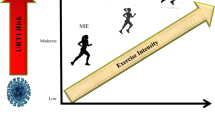Abstract
The risk of upper respiratory infections (URIs) is increased in people who are under heavy physical stress, including recreational and competitive swimmers. Additional treatment options are needed, especially in the younger age group. The aim of this study was to determine whether 1 g/day vitamin C supplementation affects the rate, length, or severity of URIs in adolescent swimmers. We carried out a randomized, double-blind, placebo-controlled trial during three winter months, among 39 competitive young swimmers (mean age 13.8 ± 1.6 years) in Jerusalem, Israel. Vitamin C had no effect on the incidence of URIs (rate ratio = 1.01; 95% confidence interval (CI) = 0.70–1.46). The duration of respiratory infections was 22% shorter in vitamin C group, but the difference was not statistically significant. However, we found a significant interaction between vitamin C effect and sex, so that vitamin C shortened the duration of infections in male swimmers by 47% (95% CI: −80% to −14%), but had no effect on female swimmers (difference in duration: +17%; 95% CI: −38% to +71%). The effect of vitamin C on the severity of URIs was also different between male and female swimmers, so that vitamin C was beneficial for males, but not for females. Our study indicates that vitamin C does not affect the rate of respiratory infections in competitive swimmers. Nevertheless, we found that vitamin C decreased the duration and severity of respiratory infections in male swimmers, but not in females. This finding warrants further research.
Similar content being viewed by others
References
Baird IM, Hughes RE, Wilson HK, Davies JE, Howard AN (1979) The effects of ascorbic acid and flavonoids on the occurrence of symptoms normally associated with the common cold. Am J Clin Nutr 32:1686–1690
Gleeson M (2007) Immune function in sport and exercise. J Appl Physiol 103:693–699
Gleeson M, Pyne DB, Austin JP, Lynn Francis J, Clancy RL, McDonald WA, Fricker PA (2002) Epstein–Barr virus reactivation and upper respiratory illness in elite swimmers. Med Sci Sports Exerc 34:411–417
Hemilä H (1992) Vitamin C and the common cold. Br J Nutr 67:3–16
Hemilä H (1996) Vitamin C and common cold incidence: a review of studies with subjects under heavy physical stress. Int J Sports Med 17:379–383
Hemilä H (1997) Vitamin C intake and susceptibility to the common cold. Br J Nutr 77:59–72. Comments in: (1997) 78:857–866
Hemilä H (1999) Vitamin C supplementation and common cold symptoms: factors affecting the magnitude of the benefit. Med Hypotheses 52:171–178
Hemilä H (2006) Do vitamins C and E affect respiratory infections? [PhD Thesis]. Helsinki, Finland: University of Helsinki; pp 56–57, 66–67. Available at http://ethesis.helsinki.fi/julkaisut/laa/kansa/vk/hemila/. Accessed May 28, 2010.
Hemilä H (2008) Vitamin C and sex differences in respiratory tract infections. Resp Med 102:625–626
Hemilä H, Chalker EB, Douglas RM (2010) Vitamin C for preventing and treating the common cold. Cochrane Database Syst Rev (3):CD000980
Hemilä H, Kaprio J, Albanes D, Virtamo J (2006) Physical activity and pneumonia in male smokers administered vitamin E and β-carotene. Int J Sports Med 27:336–341
Hume R, Weyers E (1973) Changes in leucocyte ascorbic acid during the common cold. Scott Med J 18:3–7
Ji LL (2008) Modulation of skeletal muscle antioxidant defense by exercise: role of redox signaling. Free Radical Biol Med 44:142–152
Lambert SB, Allen KM, Druce JD, Birch CJ, Mackay IM, Carlin JB, Carapetis JR, Sloots TP, Nissen MD, Nolan TM (2007) Community epidemiology of human metapneumovirus, human coronavirus NL63, and other respiratory viruses in healthy preschool-aged children using parent-collected specimens. Pediatrics 120:e929–e937
Monto AS, Ullman BM (1974) Acute respiratory illness in an American community. I. Swimming-associated health risk. JAMA 227:164–169
Moolla ME (1996) The effect of supplemental anti-oxidants on the incidence and severity of upper respiratory tract infections in ultra-marathon runners [MSc thesis]. University of Cape Town, South Africa
Peters EM, Goetzsche JM, Grobbelaar B, Noakes TD (1993) Vitamin C supplementation reduces the incidence of postrace symptoms of upper-respiratory-tract infection in ultramarathon runners. Am J Clin Nutr 57:170–174
Peters EM, Goetzsche JM, Joseph LE, Noakes TD (1996) Vitamin C as effective as combinations of anti-oxidant nutrients in reducing symptoms of upper respiratory tract infection in ultramarathon runners. S Afr J Sports Med 11:23–27
Pitt HA, Costrini AM (1979) Vitamin C prophylaxis in marine recruits. JAMA 241:908–911
Powers SK, Jackson MJ (2008) Exercise-induced oxidative stress: cellular mechanisms and impact on muscle force production. Physiol Rev 88:1243–1276
Ritzel G (1961) Kritische Beurteilung des Vitamins C als Prophylacticum und Therapeuticum der Erkältungskrankheiten [Critical analysis of the role of vitamin C in the treatment of the common cold]. Helv Med Acta 28: 63–68. Translation at: http://www.ltdk.helsinki.fi/users/hemila/T3.pdf. Accessed May 28, 2010.
Ritzel G (1976) Ascorbic acid and the common cold [letter]. JAMA 235:1108
Sabiston BH, Radomski MW (1974) Health Problems and Vitamin C in Canadian Northern Military Operations. DCIEM Report no. 74-R-1012. Defence and Civil Institute of Environmental Medicine; Downsview, Ontario, Canada. 10pp. Available at: http://www.ltdk.helsinki.fi/users/hemila/CC/Sabiston_1974_ch.pdf. Accessed May 28, 2010.
Seyfried PL, Tobin RS, Brown NE, Ness PF (1985) A prospective study of swimming-related illness. I. Swimming-associated health risk. Am J Public Health 75:1068–1070
Acknowledgments
The vitamin C and placebo pills for this study were kindly provided by Teva Pharmaceutical Industries Ltd., Israel.
Conflict of interest
The authors declare that they have no conflict of interest nor any financial relations with the sponsoring organization.
Author information
Authors and Affiliations
Corresponding author
Additional information
Constantini and Dubnov-Raz contributed equally to this paper.
Rights and permissions
About this article
Cite this article
Constantini, N.W., Dubnov-Raz, G., Eyal, BB. et al. The effect of vitamin C on upper respiratory infections in adolescent swimmers: a randomized trial. Eur J Pediatr 170, 59–63 (2011). https://doi.org/10.1007/s00431-010-1270-z
Received:
Accepted:
Published:
Issue Date:
DOI: https://doi.org/10.1007/s00431-010-1270-z




